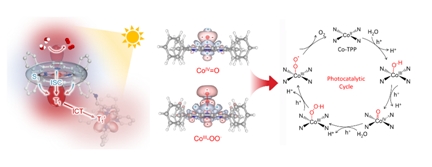The photocatalytic water oxidation process plays a vital role in attaining efficient solar-to-chemical process by enabling photocatalytic water splitting and CO2/N2 fixation. However, the lack of well-designed photocatalysts to overcome the sluggish kinetics of water oxidation has impeded ongoing research. Therefore, it is very important to uncover the inner mechanism and develop an efficient water oxidation photocatalyst.
In a study published in Science Advances, Prof. WANG Yaobing’s team from Fujian Institute of Research on the Structure of Matter of the Chinese Academy of Sciences, proposed a novel approach involving the rational design of an ionic-type covalent organic framework (CoTPP-CoBpy3) with atomic ultrathin nanosheets morphology, high water-affinity, efficient charge separation, and kinetic favored water oxidation mechanism. The CoTPP-CoBpy3 water oxidation photocatalyst overperforms the most of previously reported COF-based photocatalyst.
The researchers demonstrated the ultrathin nanosheet morphology of CoTPP-CoBpy3 in various solvents by atomic force microscopy (AFM) and cryo-TEM(transmission electron microscopy). They confirmed the superhydrophilicity by contact angle measurements (CAs), zeta potential tests and density functional theory(DFT) calculations.
Based on the analysis of the charge separation property by fs-TA spectra, the researchers realized the ultrafast intramolecular charge transfer (ICT) between two triplet states (1.8 ps), a prolonged excited state lifetime (> 1.2 ns) and the relayed electron transfer pathway (S1-T1-T1'). By combining DFT calculations and in-situ ATR-IR spectroscopy, the researchers demonstrated an end-on type superoxide radical adsorption in the single cobalt active site for the first time, suggesting a kinetically favored water oxidation pathway.
Besides, the researchers proposed an electron-intermediate cascade mechanism of synergistic coupling of the relayed electron transfer pathway (S1-T1-T1') and catalytic water oxidation intermediate evolutions. Such an electron-intermediate cascade mechanism emphasizes that the electron-relayed state of the Co active site could be more beneficial for water oxidation rather than an extreme hole accumulation.
This study presents an efficient water oxidation photocatalyst design, which offers a promising example for the further exploration on high-performance water oxidation photocatalysts.

Schematic representation illustrating the electron-intermediate cascade mechanism in water oxidation.(Image by Prof. WANG Yaobing’s group)
Contact:
Prof. WANG Yaobing
Fujian Institute of Research on the Structure of Matter
Chinese Academy of Sciences
Email: wangyb@fjirsm.ac.cn